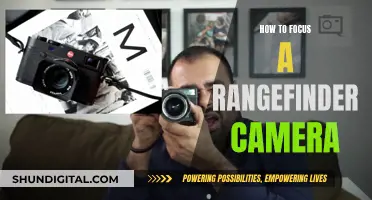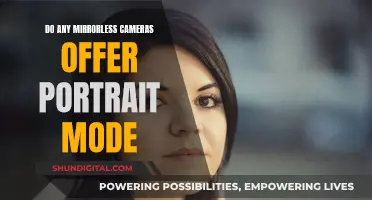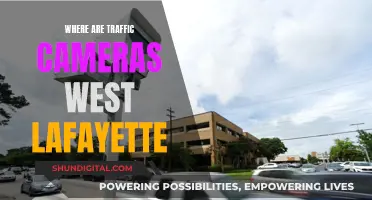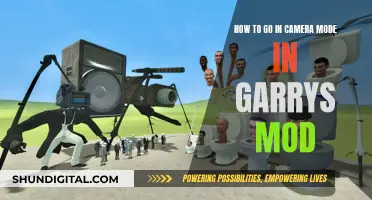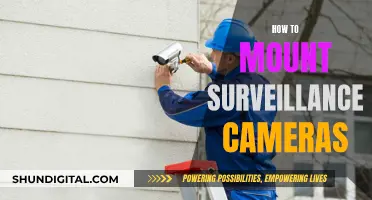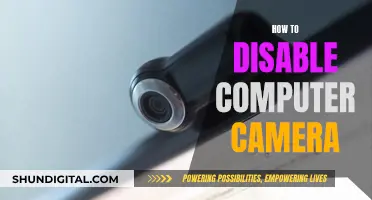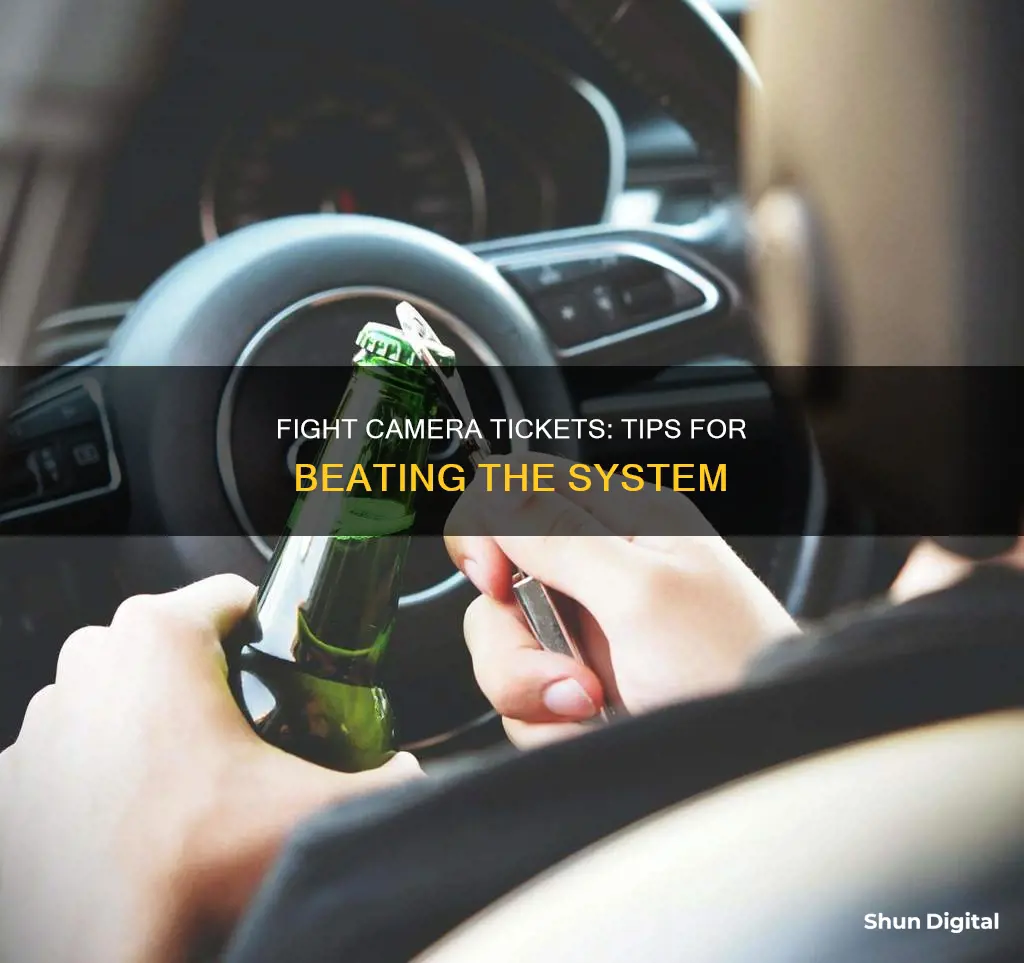
Getting a ticket from a traffic camera can be frustrating, but there are ways to fight it. The first thing to do is to examine your ticket and the accompanying photo. If the photo is blurry, or your car and license plate are unrecognisable, you can argue that the evidence is inconclusive. You can also argue that the camera may have malfunctioned, or that the photograph is inadmissible in court as hearsay. If the ticket was sent to the owner of the car, rather than the driver, you can also argue that someone else was driving the car at the time.
What You'll Learn

Argue the reliability of the camera
When fighting a traffic camera ticket, it is important to know how to argue the reliability of the camera in question. Here are some ways to do that:
Question the Camera's Functionality
Ask whether the camera was working properly when it generated your ticket. Cameras are machines that can malfunction. If the prosecution cannot prove that the camera was functioning correctly, they do not have a solid case. Ask if those reviewing the pictures can make mistakes in deciding on the accuracy of the image. Also, inquire about the last time the camera was maintained.
Argue That the Photograph is Hearsay
In some jurisdictions, a red-light camera photo is considered hearsay. Hearsay is an out-of-court statement presented in court to prove the truth of the matter asserted. In this case, the photo is an out-of-court "statement" that the prosecution is attempting to use to prove you violated the traffic law. Hearsay evidence is generally inadmissible unless it fits into one of the exceptions.
Assert Your Right to Confront Witnesses
The Sixth Amendment of the Constitution guarantees you the right to cross-examine witnesses. Unless a witness appears who maintains the record and system associated with the camera, you do not have this opportunity.
Dispute the Authenticity of the Photograph
If no one from the company that maintains the camera shows up to testify, object to the use of the photographs for lack of foundation. For the prosecution to rely on the photos, they must present evidence that the camera, the system that connects it to the traffic light, and the traffic light itself were functioning properly. Without establishing this foundation, the photo is not reliable and cannot be admitted into evidence.
Request Maintenance Records
Request full maintenance records for the camera and the traffic light or speed monitoring system to establish that they were regularly monitored and maintained. If their accuracy wasn't tested within a reasonable period before your ticket was issued, the photo is potentially unreliable as evidence.
Charging Your Lumix Camera Battery: No Charger Required
You may want to see also

Check the photo for blurriness
If you've received a red-light camera ticket, you may be able to get it dismissed if the photo is blurry. Here's what to do:
First, examine the photo evidence. If the photo is blurry and it's hard to identify the driver or the license plate, you may have grounds for dismissal. Check that the license plate is legible and matches the car you own. If the photo doesn't clearly show you or your license plate, you can argue that there is no proof that it's your car or that you were driving it. If the license plate is blurry, you can argue that they can't be certain they have the right car.
Request the Photo
If photos were not included with your ticket, you may need to wait until your trial is scheduled to request copies from law enforcement. You can also request full maintenance records for the camera and the traffic light to establish that they were regularly monitored and maintained. If their accuracy wasn't tested within a short period before your ticket was issued, the photo may be unreliable as evidence.
Hire a Lawyer
It's best to have a traffic attorney represent you. If you're not familiar with traffic law, you may not be able to mount your own defence in court. Without knowing the law or how to prepare a defence, you will likely lose your case. A lawyer who specialises in traffic tickets will be familiar with traffic ticket laws and the best way to fight them.
Charging Mini DV Cameras: A Quick Guide
You may want to see also

Challenge the admissibility of the photo as hearsay
Hearsay is a statement by someone to a witness who, while testifying in court, repeats the statement. The statement is only hearsay if it is offered as evidence for the truth of its contents. In general, courts exclude hearsay evidence in trials, criminal or otherwise. The hearsay ban aims to prevent juries from considering secondhand information that hasn't been subject to cross-examination.
In the context of a traffic camera ticket, the photo is an out-of-court "statement" that the prosecution is attempting to use to prove you violated the traffic law. Hearsay evidence is inadmissible unless it fits into one of the exceptions. There are more than two dozen hearsay exceptions. Some courts have fit traffic camera photos into these exceptions, but others have not.
For example, in Broward County, Florida, a red light camera photo is considered hearsay. Research your jurisdiction to find out if this objection is available to you.
If the photo is deemed hearsay and is inadmissible, the prosecution will have to rely on other evidence to prove their case.
Understanding Camera Polarity: Ground vs. Battery Power
You may want to see also

Assert your right to confront witnesses
The Sixth Amendment of the United States Constitution guarantees a defendant the right to confront the witnesses against them. This includes the right to be physically present at the trial and the right to cross-examine the witnesses presented by the prosecutor.
The Confrontation Clause of the Sixth Amendment states that a person accused of committing a crime has the right to confront the witness in a criminal action. This protects the defendant against a conviction without an opportunity to test the veracity of the testimony of the witnesses in front of the jury. It also safeguards the defendant from a conviction solely based on written evidence, such as an ex parte affidavit.
The Supreme Court of the United States delineated three essential purposes of the Confrontation Clause:
- To allow the criminal defendant to cross-examine any witnesses that testify against them.
- To ensure that the witnesses testify under oath and provide a reasonable understanding of the seriousness of their testimony within the trial.
- To provide an opportunity for jurors to evaluate the credibility of the witness by presenting the witness in cross-examination to gauge their personality.
The right to be confronted by witnesses may be waived by the defendant either by express consent or by a failure to assert the right in a timely manner.
In the context of traffic camera tickets, the right to confront witnesses may be exercised by requesting the presence of a witness who maintains the record and system associated with the camera. This could be an employee from the company that installed and maintains the camera. They could be asked to testify about the accuracy and reliability of the camera, as well as the process of reviewing and identifying vehicles through license plate records.
It is important to note that the right to confront witnesses is not absolute and may be balanced against other considerations, such as the government's interest in effective law enforcement or the well-being of minor victims.
Polaroid Camera Battery Guide: Which Batteries to Use?
You may want to see also

Dispute the authenticity of the photo
If you receive a camera ticket, you can dispute the authenticity of the photo by arguing that the camera was not working properly. Cameras are machines and they can malfunction. If the prosecution cannot prove that the camera was working properly, they do not have a solid case.
You can also argue that the photograph is a form of hearsay and is therefore inadmissible under the Sixth Amendment. This is because you cannot cross-examine the photograph or the camera. The Sixth Amendment gives defendants the right to confront their accuser.
If the photo is blurry, you can argue that they cannot be certain they have the right car. Check if the license plate is blurry or clear. If the license plate is blurry, they may not be able to confirm that the car is yours.
You can also argue that the photo does not show you driving the car. You will be under oath, so you cannot argue that you weren't driving if you were. However, you can argue that the prosecution cannot prove you were driving or has no evidence that you were driving.
If the photo does not clearly show that you were committing a traffic violation, this may be a good defence. For example, if you were making a legal right turn on a red light when the camera took the photo, you should be able to get the ticket dismissed.
Galaxy S8 Camera Mode: Where Is It?
You may want to see also
Frequently asked questions
Examine your ticket and check the date, time, and location. Since camera tickets are usually sent to the owner of the car, confirm that you were the one driving. If not, you can't be prosecuted. If you were driving, try to remember the details of the incident and write them down.
You can argue that the camera was not working properly at the time it generated your ticket as cameras can malfunction. Additionally, you can dispute the ticket if the photo is blurry and neither you nor your license plate is recognizable.
You can argue that you were speeding out of necessity to avoid harm to yourself or others. Some states also have specific rules about warning signs that must be posted for cameras, so if these were missing or obscured, you may have a defense.


